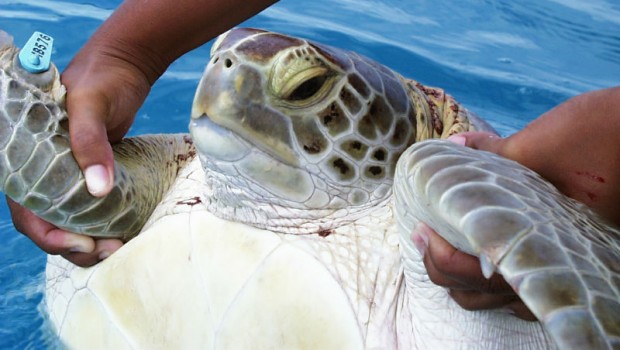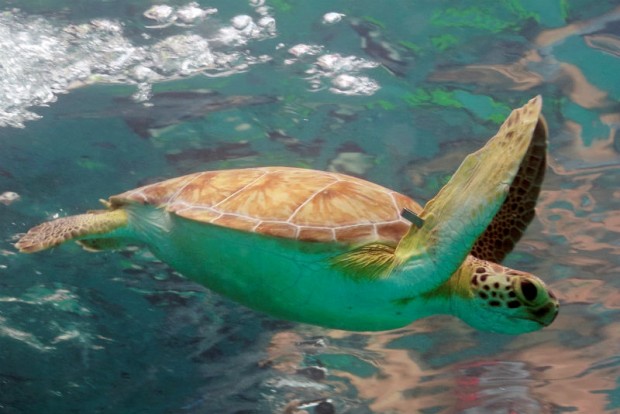Bermuda Tagged Turtles In Costa Rica & Mexico
The Bermuda Turtle Project has revealed that three turtles originally tagged in Bermuda in the 1990s have been seen on nesting beaches in Costa Rica and Mexico, each bearing titanium tags that were put on them during turtle tagging sessions by the Bermuda Turtle Project.
“These results demonstrate the linkage between young green turtles that grow up in Bermuda waters and Caribbean nesting beaches that are thousands of kilometers away,” explained Dr. Anne Meylan, who, along with husband Dr. Peter Meylan, serve as the project’s scientific directors. “They also show the long period of time it takes for green turtles to reach sexual maturity – some 30 years or more.”
Research into Bermuda’s green turtles began in 1968 by Dr. H.C. Frick, a trustee of the Caribbean Conservation Corporation, and continues to this day under the Bermuda Turtle Project, which is a joint effort between the Sea Turtle Conservatory, the Atlantic Conservation Partnership, the Bermuda Zoological Society, and the Bermuda Aquarium, Museum and Zoo.
Through the years, more than 3,500 turtles have been captured, tagged, and released, providing data on the island’s juvenile green sea turtle population. Turtles tagged in Bermuda have also been recovered in Nicaragua, Panama, Cuba, Dominican Republic, Grenada, St. Lucia, and the United States.
A tagged turtle [photo courtesy of Jennifer Gray]
According to Dr. Meylan, “Few projects have recorded migrations between the habitats that green turtles inhabit when they are immature, and their nesting beaches. Recaptures of this kind present a rare opportunity to test whether theoretical estimates of age-to-maturity are correct. The data are only possible because of the long-term tagging effort in Bermuda and careful beach monitoring at the nesting sites.
“We have thought for many years that Bermuda serves as an important steward for Caribbean green turtles, providing a safe and healthy environment in which they can mature. These recent recaptures are direct evidence of the link between developmental habitat in Bermuda and nesting beaches in the Caribbean.
“The BTP brings students from the Caribbean to Bermuda every year for a course in sea turtle biology and conservation. These three recapture records confirm the relevance of Bermuda to sea turtle conservation in their native countries, including Mexico and Costa Rica, where the recaptures were made.”
Bermuda Turtle Project Coordinator Jennifer Gray said, “It takes years of standardized research and an enormous effort by many people to acquire this kind of outstanding and exciting information. Bermuda can and should be very proud of our renowned conservation of this endangered species and a research initiative that is known and applauded by sea turtle scientists around the globe.”
A tagged green sea turtle swimming [photo courtesy of Ron Lucas]
“Our findings highlight the need for international cooperation to protect the species across the vast distances they travel and the many places where they develop, feed, mature and nest. Sea turtles know no international boundaries and, as long-lived species, are hard-wired to continue a life cycle that takes place in a number of geographical ranges throughout their lives.
“They have been on this earth for more than a million year and as a species have survived earth’s catastrophic events yet they struggle today to survive the threats posed by a species called man. The good news is that with more scientific data and a better understanding of their life history the world will be in a better position to conserve this wonderful species.
“Having seen a large number of our Bermuda-tagged turtles taken from the sea by fishers overseas it is really gratifying now to see them nesting on the beaches where they were born, thus starting the cycle all over again. These are the results obtained after many years of conservation protection in our waters and nearly 50 years of study.
“We are indebted to all of our donors, volunteers, students, and team participants who have made this work possible and to a Bermuda which cares for our marine life.”
The full report was recently shared in an article in the Marine Turtle Newsletter, available online.
Read More About
Category: All, Environment, News




Even the turtles are getting away.
Life’s a beach in Costa Rica.
My thoughts exactly. Save Daniels Head from the jet ski yobs and motor boats.
If this “crap” of recent times continues on the Island, it just maybe wise to pay heed to the green turtles and relocate before there’s nothing left here
From reading the article it is apparent that the green sea turtle travels in warm water oceans judging by the countries in which they appear and re-appear.
They are hard-wired to visit and return to many of the world’s most exotic locations, they appear to be pretty damn smart to me and noted, they migrate but have not given up on Bermuda outright.
London, England